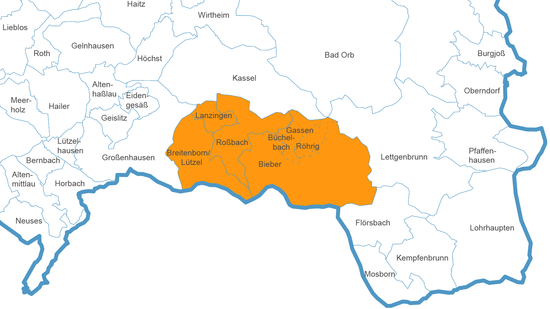Office Bieber
The Bieber office , also: Bieberer Grund , was an office in the County of Hanau-Munzenberg and then the Principality of Hanau and the Province of Hanau in the Electorate of Hesse. It came from the Rieneck inheritance .
function
In the early modern period , offices were a level between the municipalities and the sovereignty . The functions of administration and jurisdiction were not separated here. The office was headed by a bailiff who was appointed by the rulers.
Territorial history
In 1333 the brother of Ulrich II. Von Hanau's mother , Count Ludwig V von Rieneck , died, with which this line of Count von Rieneck died out. Through an agreement between the deceased and Ulrich I von Hanau from 1296, the Rienecker's feudal rights were transferred to Hanau . However, Ludwig V had decreed in 1329 that his daughter Udelhilt should take over the inheritance. From this constellation an extensive inheritance dispute developed, in which other lines of the Rieneck house and the greatest feudal lords, Kurmainz and the Bishopric of Würzburg participate. Ultimately, however, Ulrich II managed to get at least half of the office of Bieber von Kurmainz as a fief. The Bieber office thus became a condominium , initially between the Counts of Rieneck and the Lords of Hanau, both of whom held half as fiefs of Kurmainz. When Count Philip III. von Rieneck, the last male member of his family, died on September 3, 1559, his part reverted to Kurmainz. The condominium now existed between Kurmainz and the County of Hanau-Münzenberg , with the Hanau half of it still being a fiefdom of Kurmainz. In 1684 the Mainz half - also as a fiefdom of Mainz - fell completely to the County of Hanau in exchange for the Hanau half of the Partenstein office , which was also shared with Mainz .
1736 died with Count Johann Reinhard III. the last Count of Hanau and the county of Hanau-Munzenberg fell to the Landgraviate of Hesse-Kassel . In 1821 there was a fundamental administrative reform in the former Landgraviate, now known as the “ Electorate of Hesse ”. The office of Bieber was added to the newly formed district of Gelnhausen . With the regional reform in Hesse , this district then became part of the Main-Kinzig district in 1974 .
Mining
The office was significant due to mining , a major source of income for the County of Hanau in the 18th century. The mining industry, first mentioned in 1494 in a legal act between Kurmainz and Hanau, concentrated on copper , silver and lead . Leaders in the Office's mining operations were the Cancrin family . She led the mining and steel industry, which had been state-owned since 1739, from 1741 to 1790. It was only during this time that mining in Bieber became more important than other small mining areas in the Spessart. At times between 400 and 500 people were employed. Between 1754 and 1803 silver was minted in Kassel and Hanau into coins, the Bieber exploitation thalers (and guilders). A total of around 40,000 to 45,000 of these are said to have been spent. Copper mining was stopped soon after 1802 due to depletion of the deposits.
Components
The villages belonged to the office of Bieber
-
Beaver
- Büchelbach (today part of the Bieber district)
- Gassen (now part of the Bieber district)
- Röhrig (today part of the Bieber district)
Population development
- 1632: 134 families
- 1707: 154 families
- 1754: 1,121 inhabitants
literature
- Engelhard, Regenerus, Erdbeschreibung der Hessische Lande Casselischen Antheiles with notes from the history and from documents explained, part 2, Cassel 1778, ND 2004, p. 790ff.
- Freymann, Klaus, Metal ore mining in the Spessart = Publications of the History and Art Association Aschaffenburg 1991.
- Haase, Franziska, Ulrich I., Lord of Hanau 1281-1306, masch. Diss. Münster 1924, p. 11.
- Landau, G., Historical-topographical description of the desolate localities in the Electorate of Hesse ... = Journal of the Association for Hessian History and Regional Studies, 7th Supplement, Kassel 1858, p. 376.
- Puchert, Helmut, Der Hessische Spessart - Contributions to the history of forest and hunting = messages from the Hessian Forest Administration 23 = series of publications by the Hessian Forest Culture Museum Bieber 3.
- Reimer, Heinrich, Historisches Ortlexikon für Kurhessen, Marburg 1926, p. 45.
Individual evidence
- ^ Theodor Ruf: Hanau and Rieneck. About the changeable relationship between two neighboring noble families in the Middle Ages . In: Neues Magazin für Hanauische Geschichte, 8th vol., No. 6, pp. 300-311 (305ff).
- ^ K. Freymann: The metal ore mining in the Spessart . Publications by the History and Art Association of Aschaffenburg in 1991.
- ↑ Examples see: http://www.spessartit.de/taler.htm
- ↑ In the years 1632, 1707 and 1754 the number of inhabitants in the county of Hanau was determined. The figures are reproduced here after Erhard Bus : The consequences of the great war - the west of the county of Hanau-Munzenberg after the Peace of Westphalia . In: Hanauer Geschichtsverein 1844 : The Thirty Years War in Hanau and the surrounding area = Hanauer Geschichtsblätter 45 (2011), ISBN 978-3-935395-15-9 , pp. 277-320 (289ff.)
